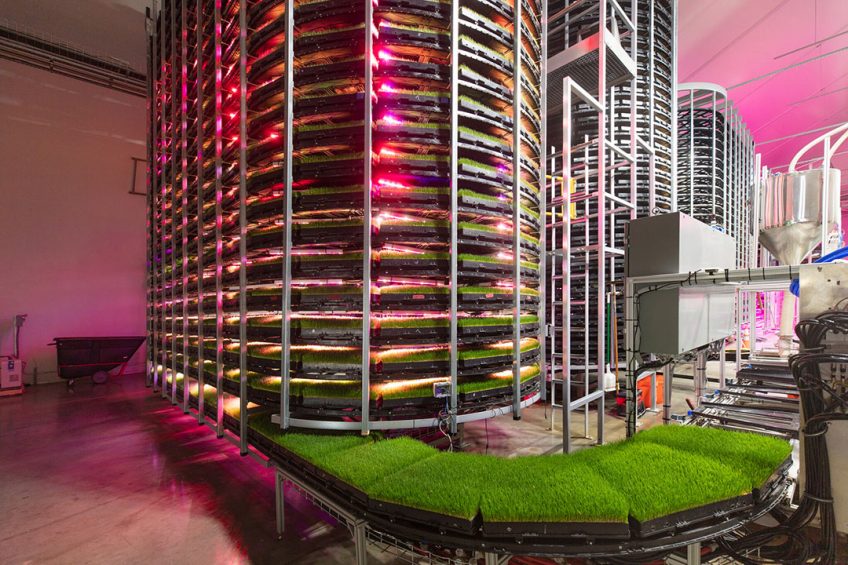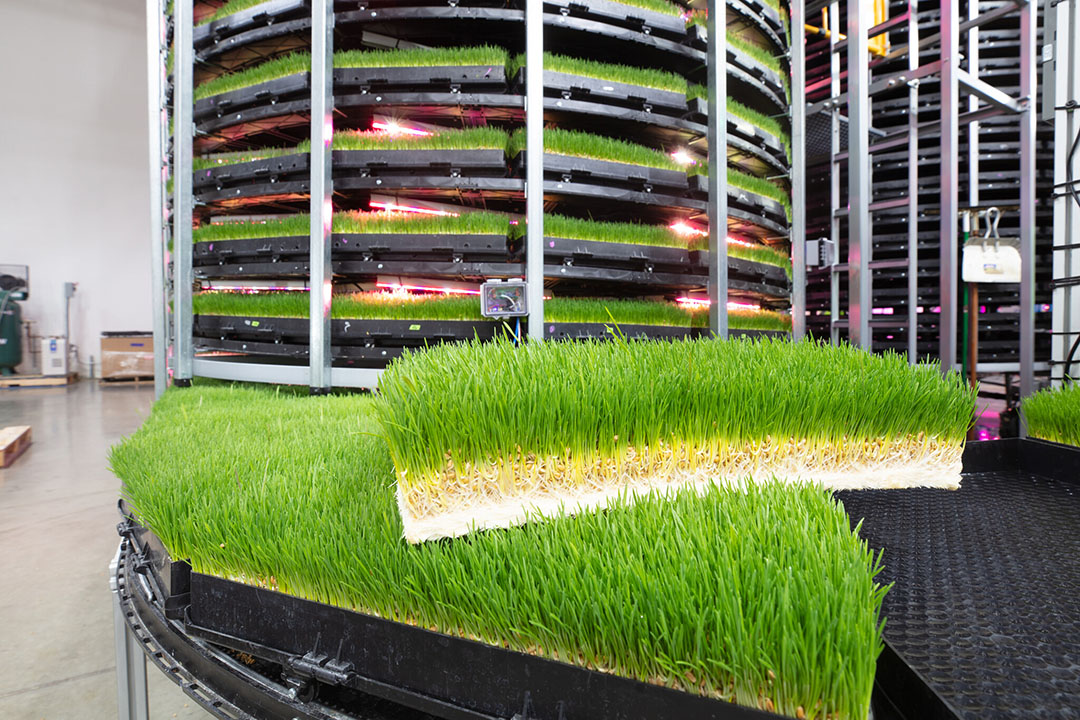Indoor robotic farming system to grow fresh cow feed

What if the area you farm is too dry to produce fresh feed for cows? A controlled indoor robotic farming system can be the answer. Not only to save on resources and labour, but also to improve animal performance.
Cnossen Dairy in Hereford, Texas, US started 45 years ago and is owned and operated by Jim Cnossen. The dairy currently milks 11,000 cows and farms over 7,500 acres of cropland. The farm is struggling through one of the driest periods on record. To deal with the water shortages and at the same time safeguard the best rations for their high producing dairy herd made them look for new technologies to incorporate on their farm. The quest resulted in an agreement with Grōv Technologies to build a controlled environment feed centre to grow fresh feed year-round. The newly built ‘Cnossen-Grōv Feed Center’ will become the largest indoor feed growing facility in the world.
Reducing drought impact
The feed will be produced indoors in ‘towers’ (the Grōv Tower Farm technology) that use machine learning growing protocols to consistently produce sprouted wheat grass, a high-density nutrient feed (HDN). The feed centre will produce over 288,000 pounds of feed per day (131,000 kg) on less than 5% of the water used in conventional farming. These savings will be critical in lessening the impact of drought conditions affecting the Cnossen Dairy, and many dairies in West Texas and across the Western US.
Being able to provide their cows with a highly nutritious consistent feed year-round will reduce the impact of droughts and changing climates and help the Cnossens deliver a more sustainably produced product to consumers.
Collaborating on the new feed centre is Dairy Specialists, a leading regional dairy supplier, who will provide local service and support for the automation, sensors, and machine learning capabilities of the new towers. Key goals in supporting the feed centre include reduction of labour and carbon emissions as they work towards becoming a Net Zero operation. Steve Lindsley, President of Grōv: “Being able to provide their cows with a highly nutritious consistent feed year-round will reduce the impact of droughts and changing climates and help the Cnossens deliver a more sustainably produced product to consumers.”
Video: Have a look at how it works at Bateman Mosida Farms
Sensors and computer vision
Cnossen dairy will be the second instalment of this tower system. Grōv is already producing about 30,000 pounds of HDN feed per day for trials at the Bateman Mosida Farms in Elberta, Utah. The Bateman dairy is the largest dairy in Utah, milking about 7,500 high producing cows. The HDN feed is produced under controlled circumstances using a cloud-based operating system, which automatically runs and monitors the towers and generators insights. Sensors and computer vision systems measure air temperature and humidity, weight, grow light values, and plant growth. This data is integrated into the operating system of each tower and will enable Grōv to seamlessly manage and improve operations at installations across the globe. This optimised way of producing feed not only saves water, time, labour and space (1 tower replaces 34-50 acres (13.7 – 20.2 Ha) of farmland!), the high-density nutrient feed is claimed to benefit health and production of livestock animals.
Speaking at the recent Animal Agtech Innovation Summit, CEO Steve Lindsley explained that the feed they produce has more protein, sugar, starch and a higher digestibility than alfalfa hay and can replace 20-60% of a TMR. “The good nutritional profile of our feed can help to improve animal health and performance, and we have also tested this in practice.”

Farm trials in dairy and beef
In cooperation with the department of animal, dairy and veterinary science at Utah State University, Grōv tested the impact of the high-density nutrient feed on holstering beef performance and meat quality on Bateman Mosida Farms. In this study, 80 Holstein beef animals were randomised into two groups and fed ad libitum either a high-energy (84% concentrate) grain-fed finishing ration (CTL) or a ration comprising up to 42% HDN wheatgrass. The study showed that HDN-fed animals showed numerically higher average daily gain of 2.9lbs vs 2.8lbs (1.315kg vs 1.27kg), and body weight after 126 days on feed compared to the CTL. Carcasses from the HDN-fed group tended to grade at a higher USDA quality grade (Choice) versus CTL (Choice minus). Meat samples from the HDN-fed group had a lower percent of trans-saturated and polyunsaturated fatty acids present in the sample and a lower ratio of omega 6:omega 3 fatty acids in comparison to a high-energy finishing ration. “We also just started a cooperation with Cornell University’s College of Agriculture and Life Sciences (home to is home to the Dairy Center of Excellence, one of the world’s premiere dairy research facilities) to lead a study on the impact of our feed on milk production efficiency and carbon footprint,” Lindsley explained.
Optimise and control
According to Lindsley, the technology they have developed is a modular system and can be applied to farms all around the world, right on the farm. “It allows us to control every aspect of a plant’s environment, giving them the ability to adjust more variables and collect more data about plant growth than ever before. This in turn will help to achieve specific customisations of nutrient expression for the optimal total mixed ration for animals. We produce superfeed for super cows and we can grow the feed fast: in 5.5 to 7 days.”
At the Animal Agtech Innovation Summit, Linsdley also addressed that the success of growing animal feed indoors is a way to do more with less. “The amount of farmland is not endless, we have to reduce pesticides and responsible use water and antibiotics. At the same time, we have learned a lot during the Covid-19 pandemic around resilience and the vulnerability of the agro-food supply chain By having a controlled, on-farm system to produce animal feed, we can improve and safeguard feed supply, optimise predictability and add value to animal, people and planet. The cost of the towers are in line with the cost of field grown fodder in many parts of the world.”
Construction on the Cnossen-Grōv Feed Center with begin in November with completion in Q2-2022.







